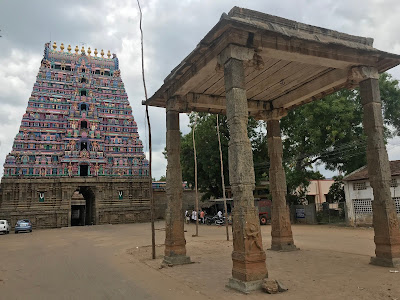Lord Hayagriva is an avatara or Sriman Narayana. He is considered the epitome of wisdom and is said to bless His ardent devotees with everything they seek with regards to enhancing their knowledge. He The Four Vedas – Rig, Yajur, Sama & Atharvana were handed over to Lord Brahma for His safe custody. Everything that happens in the Universe is said to be as per the Vedas an Lord Brahma ensures the same. Once upon a time, two asuras stole the Vedas from Lord Brahma and vanished. Sriman Narayana took the form of Lord Hayagriva – a human form with the head of a Horse to rescue the Vedas and returned it back to Lord Brahma for the well-being of His creations.
There are many temples dedicated to Lord Hayagriva across the world but the first one to come up on Earth is the one at Thiruvahindrapuram. Lord Hayagriva is seated on a small hillock which is known as Aushadagiri which is none other than a small portion of the “Sanjeevini” hill which Lord Hanuman was carrying to rescue Lakshmana at the orders of Lord Sri Rama. Aushada means medicine, Giri means hill. It is believed that the hillock is medicinal in nature. Devotees throng the shrine, especially with their wards for enhancement of their knowledge and studies at school / college / higher education. Devotees throng to this temple and offer Elachi garland to seek the Blessings of the Lord.
The temple alongside here is that of “Sri Devanayakan” referred so as the Nayakan of the Trimurthi Devas – Sriman Narayana, Lord Shiva and Lord Brahma. Lord Devanayakan is seen with “Jata-Mudi”, the hair of an ascetic symbolically referring to Lord Shiva, has a Lotus in his left hand as well as holds Shankha & Chakra, thereby displaying His form as well. Once upon a time, Lord Shiva was performing penance close by here and had a war with the Asuras. Lord Shiva fought with Lord Brahma as his Sarathy, Mt. Meru as his Bow, Vasuki as Bow string rope, the Earth as His Chariot, Moon and Sun Gods as two wheels, the four oceans as Quiver, the Vedas as Horses and Lord Vishnu’s Vajrayudha as Bow and won the war. However, the war was so intense that Lord Shiva was swept away in to the Ocean and Lord Vishnu had to rescue Him and bring back to the shore. This episode is enacted during the annual Theerthavari festival at this temple.
Once the war was over, Lord Vishnu was thirsty; so Garuda went to Vaikunta to fetch water and on the way, spilled the pot of a sage which flows here as river “Gadila” while Adisesha sprung his tail on Earth to create a spring to appease the Lord’s thirst. Thus, both the Vahanas are present in one shrine here which is among the uniqueness of this temple. Although a snake and eagle are considered enemies to one another, here they serve the Almighty together, such is the grace of the Almighty.
Another legend has it that Goddess Lakshmi was found on a lotus pond by Sage brighu who named Her Bhargavi. From childhood, she always prayed to and wanted to be beside Sriman Narayana and hence the Lord appeared in front of the sage and requested him to allow Him to marry Her which the Sage obliged. However, since the Sage would sorely miss his daughter, the Lord agreed to have the sage along with him and hence we see Sage Brighu inside the Garbagudi along with Lord Devanayakan and Goddess Hemambhujavalli (the one who was found on a golden leaf lotus). Since the Goddess would like to gaze at the waves, She is also known as TharangaMukhaNayaki – one who’s face glares the waves of the ocean.
This is also the shrine where Shri Vedanta Desikar stayed for 40 years and performed rituals to Lord Devanayakan. It is here that Shri Desikar wrote his epic “Raghuveera Gadyam” and has a separate shrine inside the main temple along with a Dwaja Sthamba.
There are also separate shrines of Sri Rama with Goddess Sita, Lakshmana & Hanuman; a separate shrine of Lord Sri Lakshmi Narasimha – a unique feature is that the Goddess is seated on His right lap unlike the norm; a separate shrine of Lord Sri Ranganatha. Thus, in one temple the Lord is seen in standing, sitting and sleeping form, a rarity as well.








